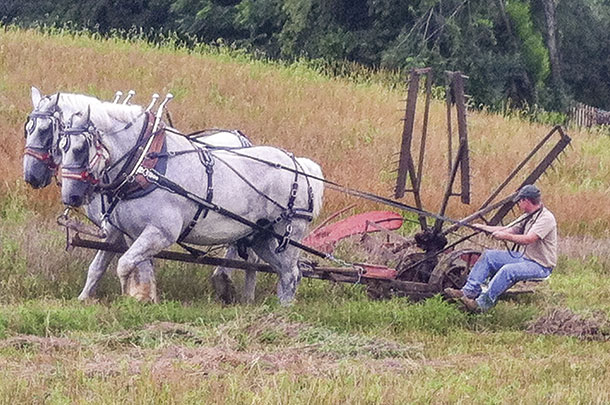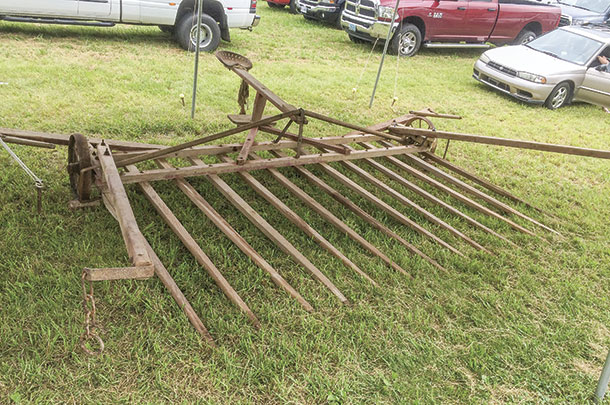Cyrus Hall McCormick invented the first mechanical reaper to harvest grain in the early 1800s. The McCormicks’ farming operation began in the beautiful Shenandoah Valley at Raphine, Virginia. One of the first successful demonstrations of the mechanical reaper took place near there at Steele’s Tavern in 1831.
Virginia Tech now operates the McCormick Farm of 620 acres as the Shenandoah Valley Agricultural Research and Extension Center, and it’s also a National Historic Landmark.
McCormick later took the business west to Chicago, Illinois, eventually becoming International Harvester, to gain access to better manufacturing facilities and farmers looking for new ways to harvest their crops. This invention was essential to increasing productivity for the farmer while also decreasing farm labor by replacing the “cradle.”
The cradle was a very labor-intensive, handheld tool with a long blade and long wooden teeth to catch and hold the grain so it could be laid gently on the ground after it was cut. A farmer could harvest around 2 to 3 acres per day using a cradle.
We went to a vintage equipment auction several years ago with no real intention of buying anything because it was so far away from home. Of course, when we got there and saw the great selection, we knew we had messed up by not bringing a trailer. We ended up buying a McCormick “Daisy” reaper, but we had to mostly disassemble it in order to haul in the bed of the truck.
Unfortunately, it stayed in this condition for about 10 years stacked up against the wall in our shop. After becoming acquainted with the Old Glade Antique Tractor Association (OGATA), I decided to see if I could get a few club members to come over and help us get it back together.
On Jan. 12, 2013 (Dad’s birthday), the reaper was put back together and, to my surprise, we hadn’t lost or misplaced a piece. The only thing missing when we bought it was the seat bracket and pan, but we were able to eventually track down an original.
This particular reaper was built around 1900 and is all original, even down to the wooden toolbox. “McCormick” is still visible in the stenciling on the swath board. The “Daisy” reaper can be folded for storage and for transport from field to field when necessary.
It is fully functional, and we were able to demonstrate it with an excellent team of Percheron draft horses at the OGATA show later that same year (Photo 1).

The demonstration was definitely a crowd-pleaser, as many folks had never seen horses at work, nor had they ever seen a reaper in person. Seeing the reaper in action was quite a thrill for everyone in attendance that day.
About four years ago, a local family contacted OGATA with interest in donating several pieces of vintage equipment. One of the most intriguing pieces we obtained was an original wooden horse-drawn sweep rake. It was in terrific condition, as it had been taken apart and hung up in a barn out of the weather.
I can imagine, since they were so big, many of them were left outside to rot when their use was discontinued or another piece of equipment replaced them. This sweep rake still had the original paper dealer tag attached. It appears it was sold and distributed by Chillicothe (Missouri) Hay Rake & Stacker Company, but we’re not completely sure if this is the brand name of this rake. We’ve seen pictures of a Jenkins sweep rake, and they look very similar.
As you can see in Photo 2, it is very wide, and the wooden teeth are about 6 feet long with metal tips on the ends to allow it to glide over the ground.

One wooden tooth was missing when we got it, but Dad and I had found two teeth in an old barn a few years before. We were able to replace the missing tooth and still have a spare.
A horse was hitched on each end of the rake, and there is a seat for a rider on the back. I’ve been told it took a great team of horses to operate the rake efficiently since the horses were working so far apart. The horses would straddle the windrow created by a dump rake and carry the hay to a central location, where a haystack would be made. The hay would have to be delivered to a different side of the stack each time to keep it even as it got taller.
At some point, I hope we are able to demonstrate the sweep rake and build a haystack during our annual show. It is truly amazing these machines have survived for so many years, especially when you consider so many of the parts are wooden.
A special thanks to the old timers that kept these treasures stored in a dry area for the rest of us to be able to enjoy and preserve. ![]()
PHOTO 1: The “Daisy” reaper can be folded for storage and for transport from field to field when necessary.
PHOTO 2: Sweep rake. Photos by Lance Phillips.








